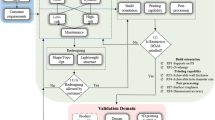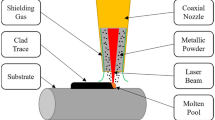Abstract
There exit model errors in the constructed Horizontally reversible plough (HRP) structure through Interference check technique (ICT). This is basically due to missing parts and geometric interference and, hence, has significantly adverse effects in improving HRP. In this paper an improved design to refine the three dimensional (3D) model of HRP is implemented by using Virtual assembly technology (VAT). To achieve this, the authors propose a combined virtual assembly semantics and constraint for assembly planning and simulation of HRP in the commercial software, e.g., SolidWorks. First, the assembly planning of HRP was captured with a semantics-based model, including spatial position, assembly orientation, type and parameters of the semantic entities; secondly, the assembly simulation of HRP was performed by using constraint-based VAT, e.g. component grasping, moving and releasing; finally, the obtained HRP model was verified through ICT again. The results demonstrate that not any model error exists in the refined 3D HRP model any longer and that semantics and constrain based VAT can support the interactive operation more effectively and accurately than those with geometric constraints. This technique was previously used for HRP model. Based on the refined 3D HRP model, the design improvement of Remote cylinder base (RCB), an important component of HRP, will be forthcoming in a future paper.
Similar content being viewed by others
References
A. Natsis, G. Petropoulos and C. Pandazaras, Influence of local soil conditions on mouldboard ploughshare abrasive wear, Tribology International, 41 (2008) 151–157.
Y. Chen, L. J. Munkholm and T. Nyord, A discrete element model for soil–sweep interaction in three different soils, Soil & Tillage Research, 126 (2013) 34–41.
L. Zhu, C.-L. Yin and F. Chen, The application of virtual prototype technology on analyzing the kinetic and dynamic characteristic of Horizontally Reversible Plow, International Journal of the Japan Society of Mechanical Engineering, Series, C (3) (2006) 247–252.
F. Chen, X.-N. Wang and L. Zhu, Mechanism design and FEA for cylinder pedestal of Horizontally Reversible Plow, Transaction of the Chinese Society for Agricultural Machinery, 35 (9) (2004) 62–66.
W.-G. Kim, S.-N. Yin, J.-Y. Park, S.-D. Hong and Y.-W. Kim, An improved methodology for determining tensile design strengths of Alloy 617, Journal of Mechanical Science and Technology, 26 (2) (2012) 379–387.
T. AlGeddawy and H. ElMaraghy, Design of single assembly line for the delayed differentiation of product variants, Flexible Services and Manufacturing Journal, 22 (3) (2011) 163–182.
X. Jin, T. Zhang and H. Yang, An analysis of the assembly path planning of decelerator based on virtual technology, Physics Procedia, 25 (2012) 170–175.
R. D. Yang, X. M. Fan, D. L. Wu and J. Q. Yan, A virtual reality-based experiment environment for engine assembly line workplace planning and ergonomics evaluation, The Second International Conference, New York, USA (2007) 594–603.
D. Wu, R. Yang, D. Ma and X. Fan, Integrated virtual assembly environment and its application in ship piping layout, International Journal of Production Research, 17 (2008) 4729–4749.
J.-H. Liu, R.-X. Ning and C.-T. Tang, Realization techniques of virtual assembly process planning system, Journal of Beijing Institute of Technology, 14 (2005) 400–405.
M. C. Leu, H. A. ElMaraghy, A. Y. C. Nee, S. K. Ong, M. Lanzetta, M. Putz, W. Zhu and A. Bernard, CAD model based virtual assembly simulation, Planning and Training, 62 (2013) 799–822.
H. Mounir, A. Nizar and B. Abdelmajid, CAD model simplification using a removing details and merging faces technique for a FEM simulation, Journal of Mechanical Science and Technology, 26 (11) (2012) 3539–3548.
Q. Yang, D. L. Wu, H. M. Zhu, J. S. Bao and Z. H. Wei, Assembly operation process planning by mapping a virtual assembly simulation to real operation, Journal of Computer Industry, 64 (2013) 869–879.
A. Seth, J. M. Vance and J. H. Oliver, Virtual reality for assembly methods prototyping: a review, Virtual Reality, 15 (1) (2011) 5–20.
H. Zhu, D. Wu and X. Fan, Assembly semantics modeling for assembling process planning in virtual environment, Assembly Automation, 30 (2010) 257–267.
W. Hui and X. Dong, Assembly planning based on semantic modeling approach, Computers in Industry, 58 (2007) 227–239.
D. Jiang, G. Na and K. Ji, Research on assembly model based on assembly constraint transformation, Procedia Eng., 29 (2012) 770–774.
H. Lodding, A. Friedewald, M. Heinig and S. Schleusener, Virtual reality supported assembly planning in the shipbuilding industry, Journal of Ship Production, 27 (2011) 146–152.
A. A. Kadir, X. Xu and E. Hammerle, Virtual machine tools and virtual machining a technological review, Robot, Comput. Integr. Manuf., 27 (2011) 494–508.
F. Case, A. Beinat, F. Crosilla, Alba Virtual trial assembly of a complex steel structure by Generalized Procrustes Analysis techniques, Automation in Construction, 37 (2014) 155–165.
Author information
Authors and Affiliations
Corresponding author
Additional information
Shuang-Shuang Peng is a master degree candidate in the Department of Mechanical Engineering at Anhui Agricultural University (P.R.China). She received her B.S. from Anhui Agricultural University in 2013. Her research interest is structure and performance optimization of mechanical components.
Lin Zhu is a Professor in the Department of Mechanical Engineering at Anhui Agricultural University (P.R.China). He received his Ph.D. from University of Science and Technology of China in 2008, and was ever a postdoc research associate at University of Wisconsin- Milwaukee (USA) from 2009. 2. to 2010.8. His current research interests include structure and performance optimization of mechanical components, mechanobiology and microfluids.
Rights and permissions
About this article
Cite this article
Zhu, L., Peng, SS., Qi, YY. et al. An improved horizontally reversible plow design based on virtual assembly semantics and constraint. J Mech Sci Technol 30, 257–266 (2016). https://doi.org/10.1007/s12206-015-1229-0
Received:
Revised:
Accepted:
Published:
Issue Date:
DOI: https://doi.org/10.1007/s12206-015-1229-0




